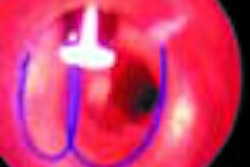VIENNA - For the evaluation and treatment of peripheral artery disease, digital subtraction angiography (DSA) continues to fade in favor of newer procedures such as contrast-enhanced MR angiography (MRA) and multi-detector row CT angiography (MDCTA). Unlike DSA, both of these techniques are noninvasive, and both can help evaluate vasculature that can't be traversed by a catheter. But which one works best?
It could be MDCTA by a nose, according to a presentation today at the European Congress of Radiology. Dr. Carlo Catalano of the Institute of Radiology at the University of Rome presented a study that compared both techniques to DSA. While both MDCTA and MRA reached comparable levels of sensitivity in identifying lesions, the researchers found that MDCTA's superior definition gives it the edge in characterizing vascular morphology, especially in distal peripheral vessels.
"We examined 21 patients with peripheral artery disease. Contrast-enhanced MRA and MDCTA were performed within 3-5 days, and in all cases, DSA was also performed," Catalano said, noting that patients with renal insufficiency were excluded.
Contrast-enhanced MRA was performed using a 3-D T1-weighted spoiled gradient-recalled echo (GRE) sequence. Three different acquisitions were performed with manual movement of the table: one at the level of the abdominal aorta, one at the thigh, and one at the level of the knees and calves. The researchers used a Magnetom Vision Plus 25 MRI scanner (Siemens Medical Solutions, Erlangen, Germany). Acquisition time was 23 seconds for each sequence, following injection of 0.5 ml of Gd-BOPTA contrast agent injected at 0.2 ml/s. Time delay was achieved by means of a test bolus.
MDCTA examinations were performed using a Siemens Somatom Plus 4 Volume Zoom multislice CT scanner. Collimation was set at 2.5 mm, and the reconstructed slice thickness was 3 mm. Reconstructions were routinely done at the level of the renal arteries, and on the distal vessels when necessary, Catalano said. The examinations were performed using a standard dose of 120 ml of iodinated contrast media, using 317 mg of iodine per ml, injected at a rate of 4 cc per second. Real-time reconstructions were obtained using either Vitrea (Vital Images, Minneapolis) or Virtuoso (Siemens) software.
Based on findings in previous studies, "we can routinely use a fixed (post-contrast) delay time of 25-28 seconds. This slightly depends on the age of the patient, and on his cardiac output," Catalano said.
According to the results, both methods achieved comparable sensitivity for overall detection of lesions: 95% for MDCTA vs. 93% for contrast-enhanced MRA.
However, a high degree of calcification can result in phase-dispersion problems with MRA. The resulting signal loss can inhibit visualization of severe stenoses and exaggerate their length. All cases of severe stenoses appeared longer than the same stenoses imaged with MDCTA, he said.
"One of the main advantages of MDCTA is that you can go back and look at the residual lumen compared with the entire lumen," Catalano said.
Because it's possible to zoom through the axial data rapidly to evaluate vessel morphology, MDCTA was superior to MRA for evaluating the degree of stenosis. And MDCTA's higher spatial resolution provided more useful information about vessel structure, especially in the distal trifurcation vessels, he said.
Finally, faster acquisition and exam preparation times with MDCTA made it more acceptable to patients, who are in and out of the exam in two minutes, according to Catalano.
At the same time, MRA can be used to study larger volumes than MDCTA, and avoids radiation exposure and the need for iodinated contrast agents in a mostly elderly patient population, he said.
"With contrast-enhanced MRA, a significant advantage is that reconstructions are much easier to perform" Catalano said. Yet even the MDCTA reconstructions were completed in about 15 minutes.
"In conclusion, we can say that both techniques are very rapidly improving," he said. "In our experience, MDCTA appears to be, for several (reasons), slightly superior to contrast-enhanced MRA -- probably also due to the fact that we did not use either moving tables or dedicated (MR) coils."
In the near future, CT scanners will be able to produce 32 slices per second, and faster gradients will improve MRA as well, he said. For now it's clear that DSA is disappearing fast. The best course of action is to use both contrast-enhanced MRA and MDCTA for the applications they're best suited to, Catalano said.
By Eric Barnes
Auntminnie.com staff writer
March 2, 2001
Copyright © 2001 AuntMinnie.com



















